Temping a Steak Doesn’t Make It Dry! Debunking a Kitchen Myth
Have you ever heard this one? “You should never poke your steak with a thermometer probe, as it will just let out all the juices while you’re cooking!”
We hear this fairly regularly on social media and in forums and it always makes us cringe. The idea that a steak, or any other cut of meat, is like a water balloon waiting to be popped seems a little preposterous on the face of it. It seems clear to us that the tiny amount of moisture lost in probing a cut of meat would be more than offset by the moisture retained by not overcooking it!
That said, we procured a jewelers scale capable of reading changes in weight up to 0.01g, cut some strip steak into equal portions and headed into the demo kitchen this week to see if we could prove it.
Hypothesis
The amount of liquid lost from probing a steak while cooking will be equal to or less than the liquid lost by overcooking the steak by 10 or even 5°F (3 to 6°C). Hence, it would be better to probe the steak and lose a little juice from the probe puncture than to NOT probe it and thereby overshoot the target pull temperature.
For the purposes of this experiment, we assumed a target finish temperature of 130°F (54°C) for a perfectly cooked medium rare doneness. We also cooked steaks to 135°F (57°C) and 140°F (60°C) to simulate overcooking.
Experimental procedure
For this experiment, we purchased one whole strip loin which we cut up into 2” cubes as measured by a ruler. We obtained 19 cubes from the loin of relatively even leanness and marbling.

The cubes were divided into four groups of four steaks each, with three steaks left over as doneness guides. Each group was assigned a designation, 1–4, with each of the four steaks in each group further designated with a letter, A–D.
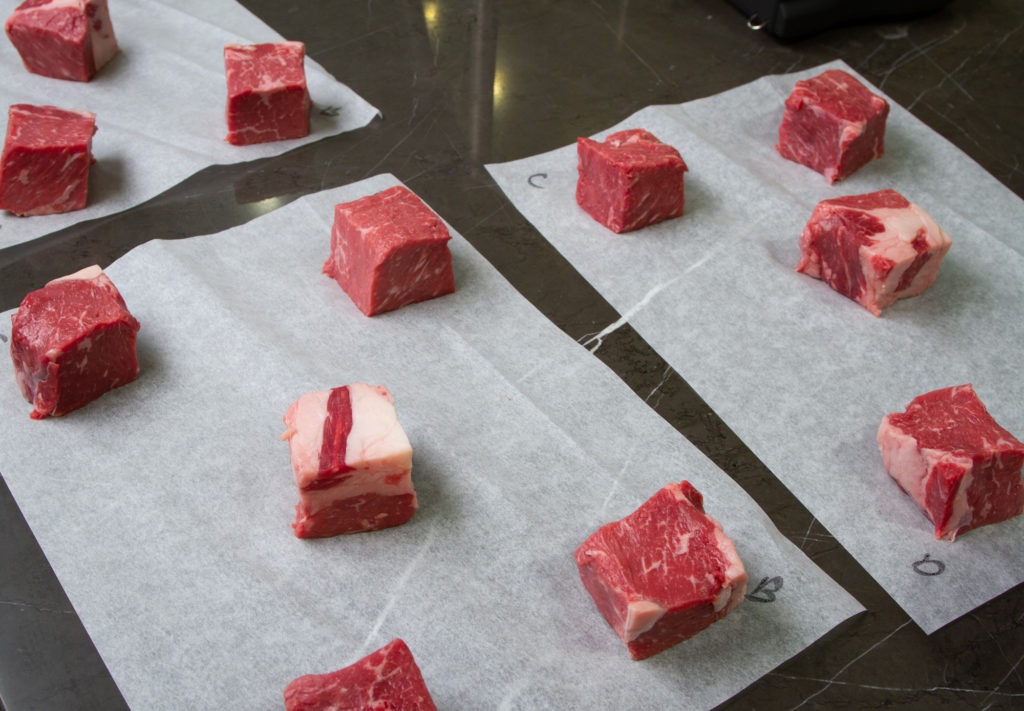
Prior to cooking, each steak was weighed on a calibrated scale with an accuracy of 0.01 grams (0.00035 oz) and its mass recorded. Each set of steaks was salted with precisely 2 grams of salt per steak.
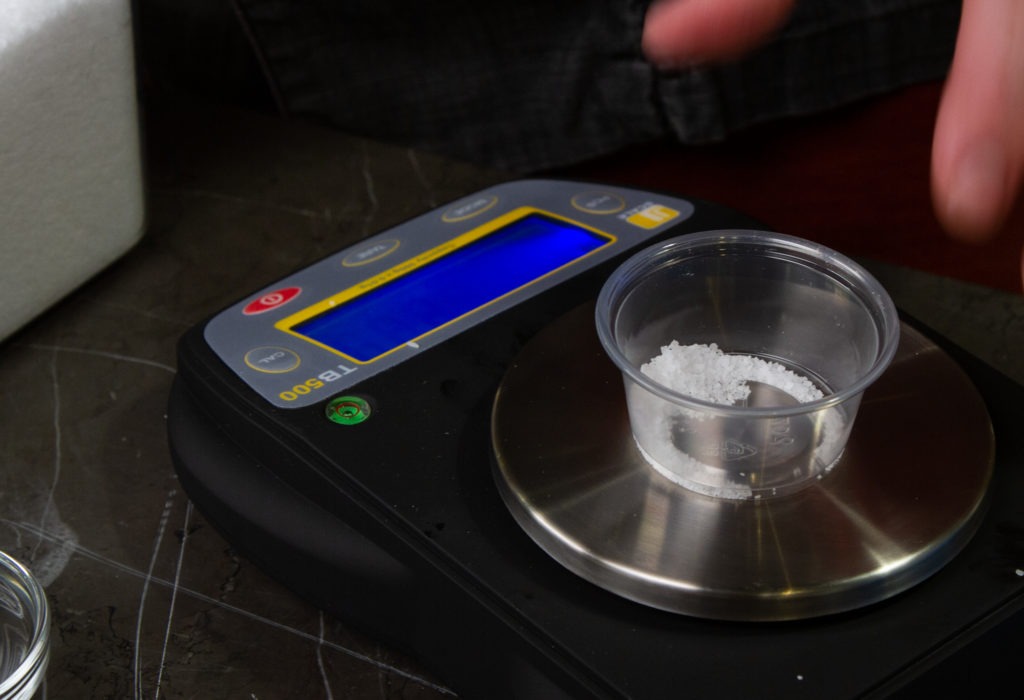
The steaks were each then seared in a cast iron skillet set over an induction cooktop (to avoid hot spots ) for 3.5 minutes on one side, flipped, and seared for an additional 3.5 minutes on the opposite side. Each steak was weighed again, and its mass recorded.
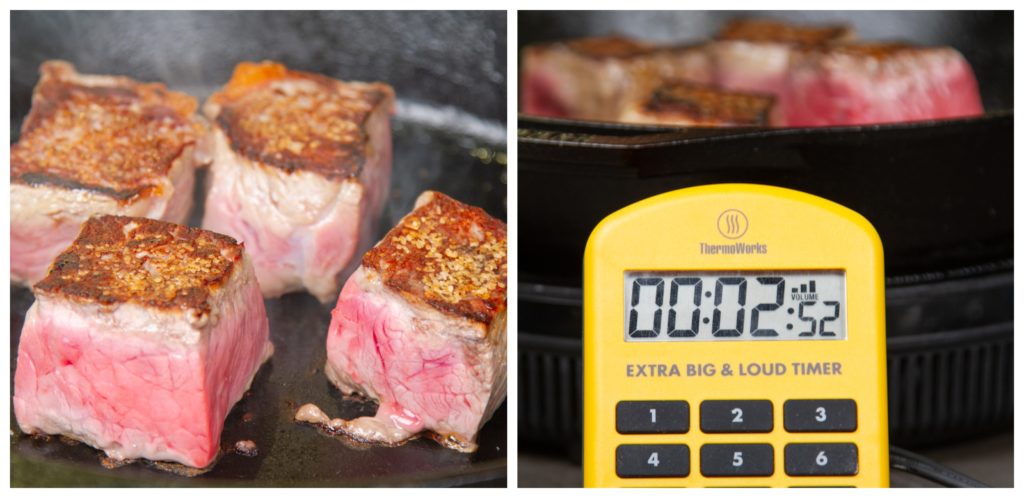
The steaks were next all placed in vacuum-pack bags, sealed, and labeled. Each group of steaks was assigned to a different preheated, temperature-controlled sous-vide baths set precisely two degrees above the target steak doneness temperature, as follows:
- Group 1: 132°F (56°C)
- Group 2: 132°F (56°C)
- Group 3: 137°F (58°C)
- Group 4: 142°F (61°C)
We designated Group 1 as our control group, meaning that these four steak cubes that would be cooked to a proper temperature for medium rare but not probed with a Thermapen®. Group 2 was cooked to the same
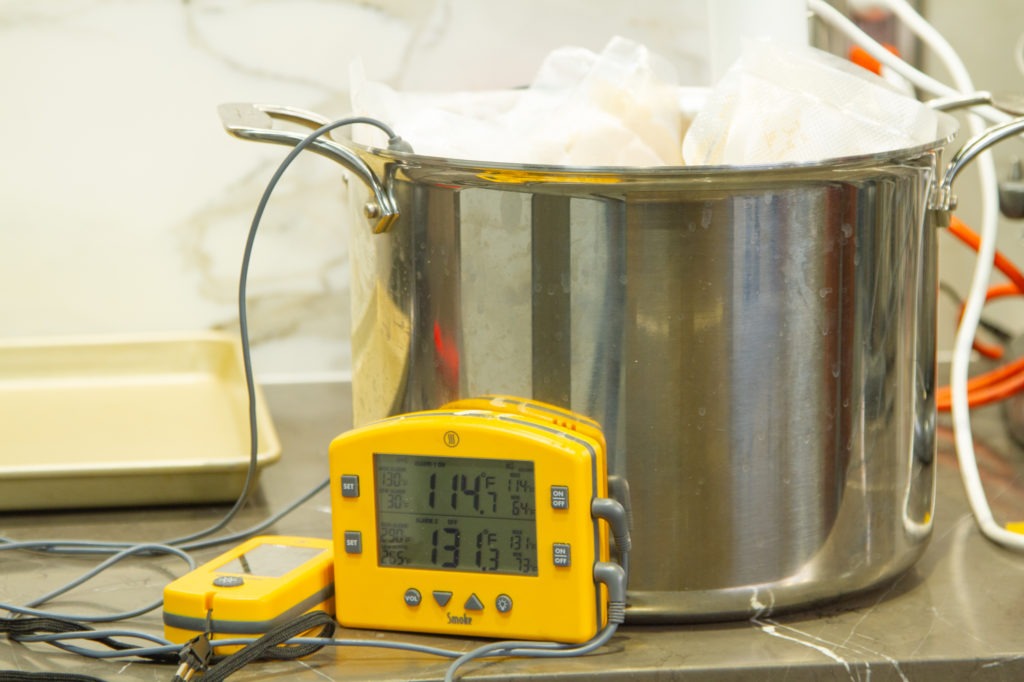
We also placed a vacuum-sealed but unseared steak cube in each sous vide bath and pierced it with a Pro-Series® Waterproof Needle Probe through waterproof Sous Vide Foam Tape. We attached these probes to two Smoke™ Alarm thermometers and set high alarms to the desired finish temps so we could monitor the internal doneness of the steaks in each bath, as well as the water temperature.
When the Smoke high alarms sounded, each batch of steak cubes was removed from the water, their bags cut open, and the entire contents of each bag emptied into a resting dish.

The steaks were allowed to rest for 3 minutes each before being blotted off with a single quartered paper towel and weighed. The mass of each steak cube was again recorded and the difference between its pre-cook and post-cook weight calculated.

For Group 2, each steak cube was pierced through with the probe of a Thermapen after cooking and before resting. This is the group that was meant to represent checking your steak with a thermometer and pulling it at the correct temperature.
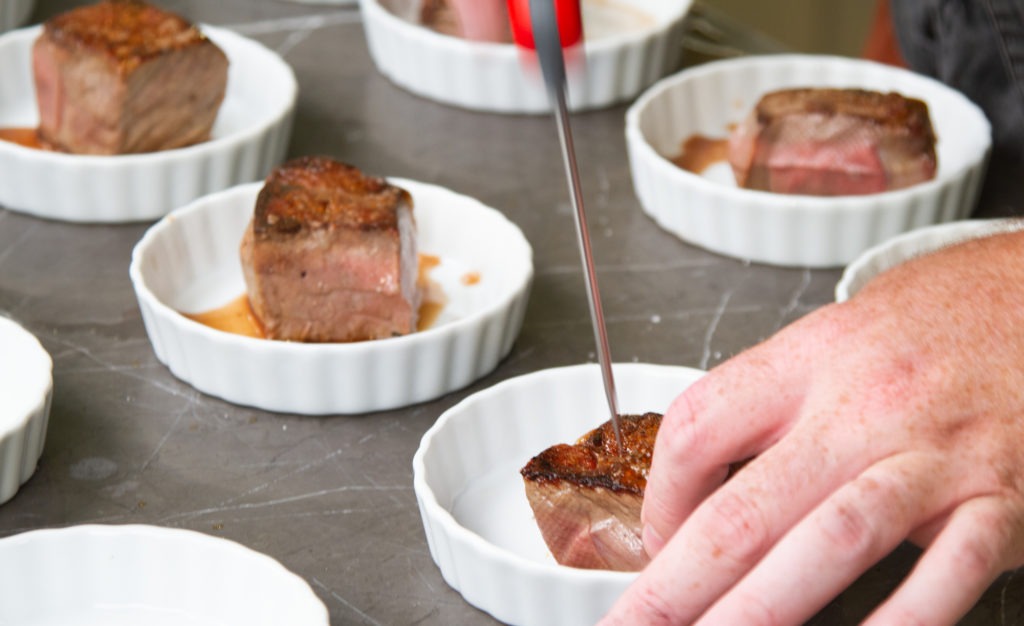
Below is the chart showing our data. You can see the initial masses of the cubes, the mass after searing, and the final mass. The salient data is the difference between the mass after searing and the final mass. (Some mass was lost during searing, but as all the steaks had an equal sear, the mass loss was independent of the degree of overcooking. All overcooking occurred during the sous vide stage.)*
Table of Results:
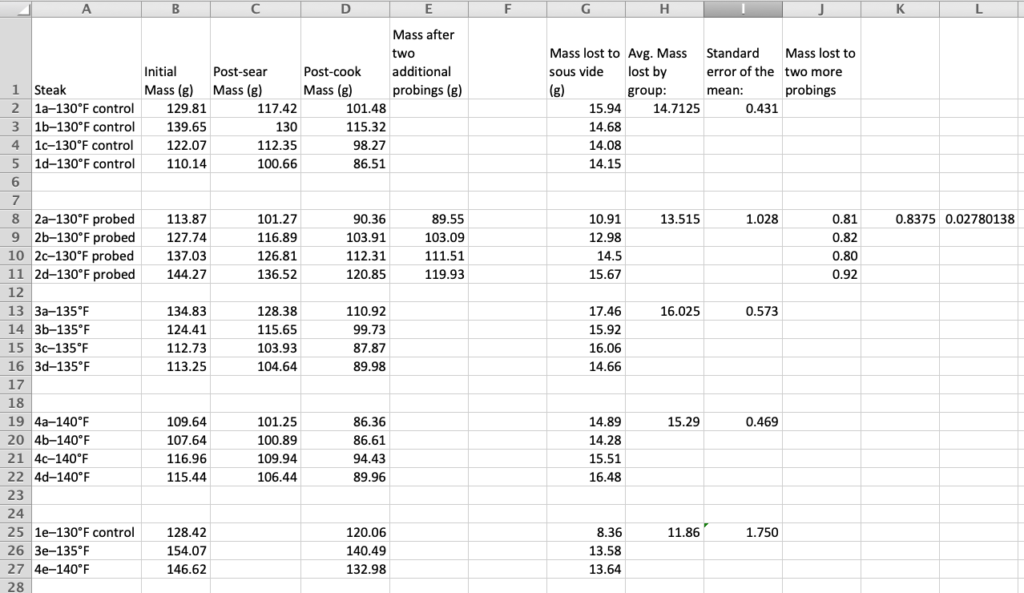
Interpretation of data
You can see that Groups 1 and 2 had the smallest loss of mass, Group 1 losing an average mass of 14.71±0.43 g, and Group 2 losing 13.51±1.03 g of juices. That may seem odd, as the unprobed steaks seem to lose more juice than the probed steaks, but they are within experimental error of each other.
Groups 3 and 4, which were unprobed but overcooked by 5 and 10°F (3 and 6°C) respectively lost more mass per steak, 16.03±0.57 g and 15.29±0.47 g respectively.
From this, we can conclude that you retain more juice by probing your steak and cooking it properly than by not probing it, trusting that you’re cooking it correctly, and overcooking by 5 or 10°F (3 or 6°C).
In fact, when we look at the mass lost in Groups 1 and 2, we see that the juice that is lost by probing is statistically insignificant. Probing a steak releases practically no juice.
Furthermore, we stabbed Group 2 two more times with a Thermapen after the post-cook weigh-in, let them rest, and then weighed them again. The results show an additional moisture loss of only 0.84±0.02 g with three puncture holes in each steak cube.
What’s going on here?
The idea that puncturing a steak somehow releases a flood of juices presupposes a free-flow of juices throughout the whole, with protein pressures in one location applying force to another location. But that just isn’t how muscle tissue is constructed! When we stick a steak with a thin, sharp probe, the only water that has any force acting on it to push it out is the water that is surrounded by the displaced fibers. That small channel of juice escapes, but the tightening fibers across the steak don’t force any more water out.
On the other hand, when a steak continues to cook beyond 130°F (54°C), the protein fibers in the whole steak continue to tighten, squeezing out more and more of their juices. By the time 140°F (60°C) is reached, though still rather pink in appearance, enough water has been lost to render the steak fibrous, chewy, and vaguely metallic in taste.
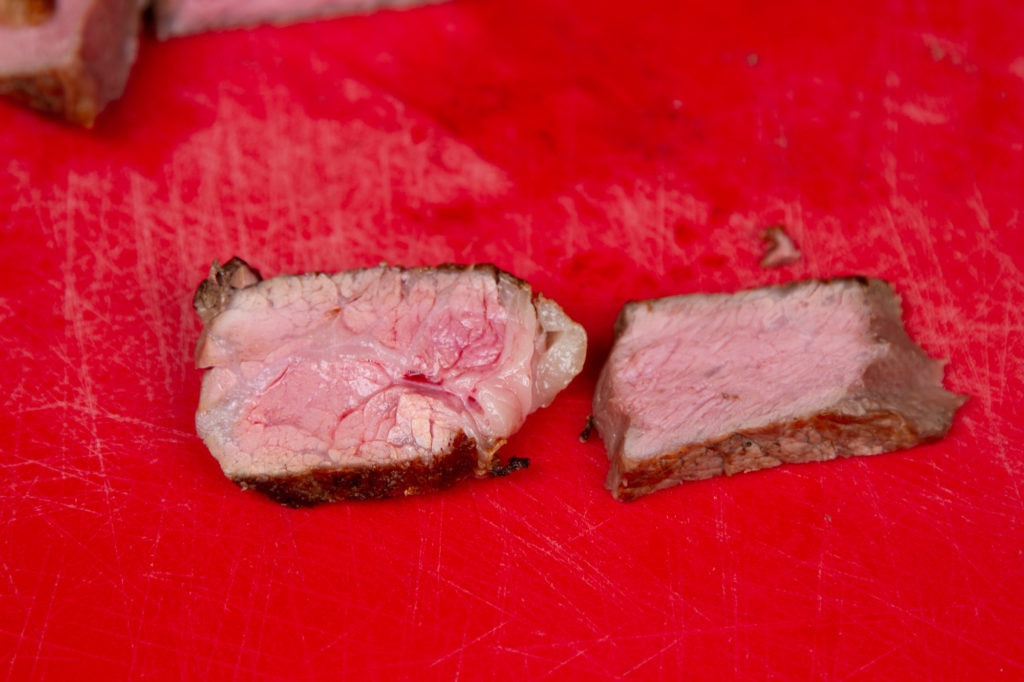
Note that though the steak cooked to medium is still quite pink, it is drier and chewier. That is because color is not a good indicator of doneness in meat. Only temperature is.
Conclusion: Overcooking steak by even five degrees dries it out more than multiple probe punctures
After cooking 16 cubes of steak at three different temperatures with a highly accurate scale, we can definitively conclude that probing your steak to check its doneness does not dry it out by spilling its juices. Even with multiple pokes, a steak that is cooked properly is still juicier than a steak that is slightly overcooked with no holes in it. The thin-gauge probe of the Thermapen® thermometer doesn’t cause enough wide-spread damage in the meat fibers in a cut of meat to drain its water, but it does help you know when to get it off the heat so that it’s cooked perfectly.
So probe your steaks confidently and enjoy juicier meats every time!
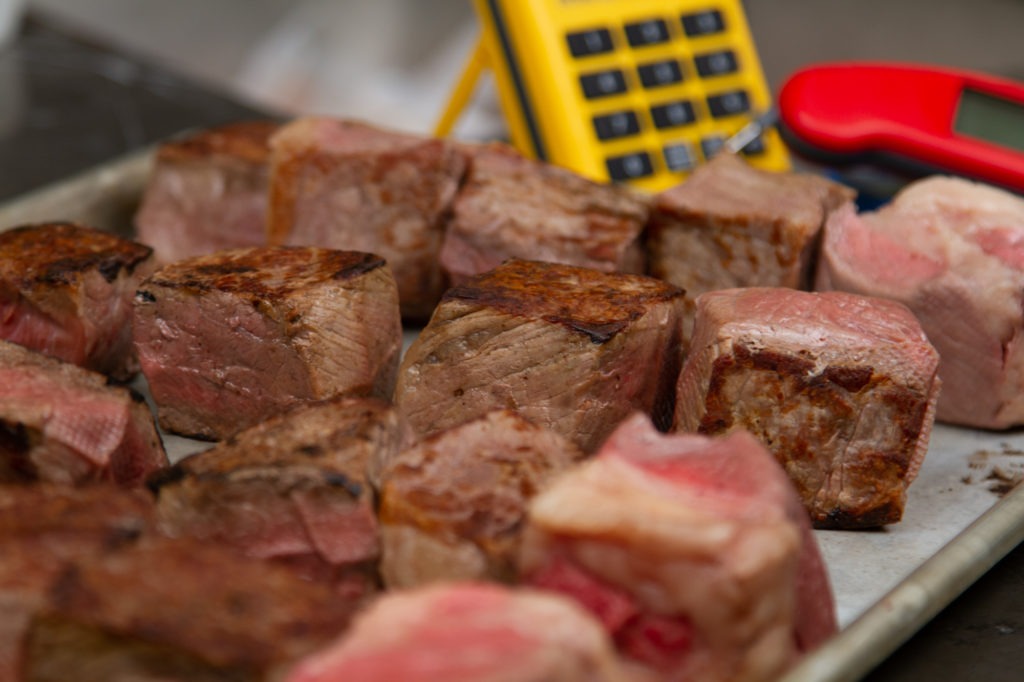
* The error reported in the error column is the standard error of the mean, a measure of the error in the distance from the average.
Shop now for products used in this post:


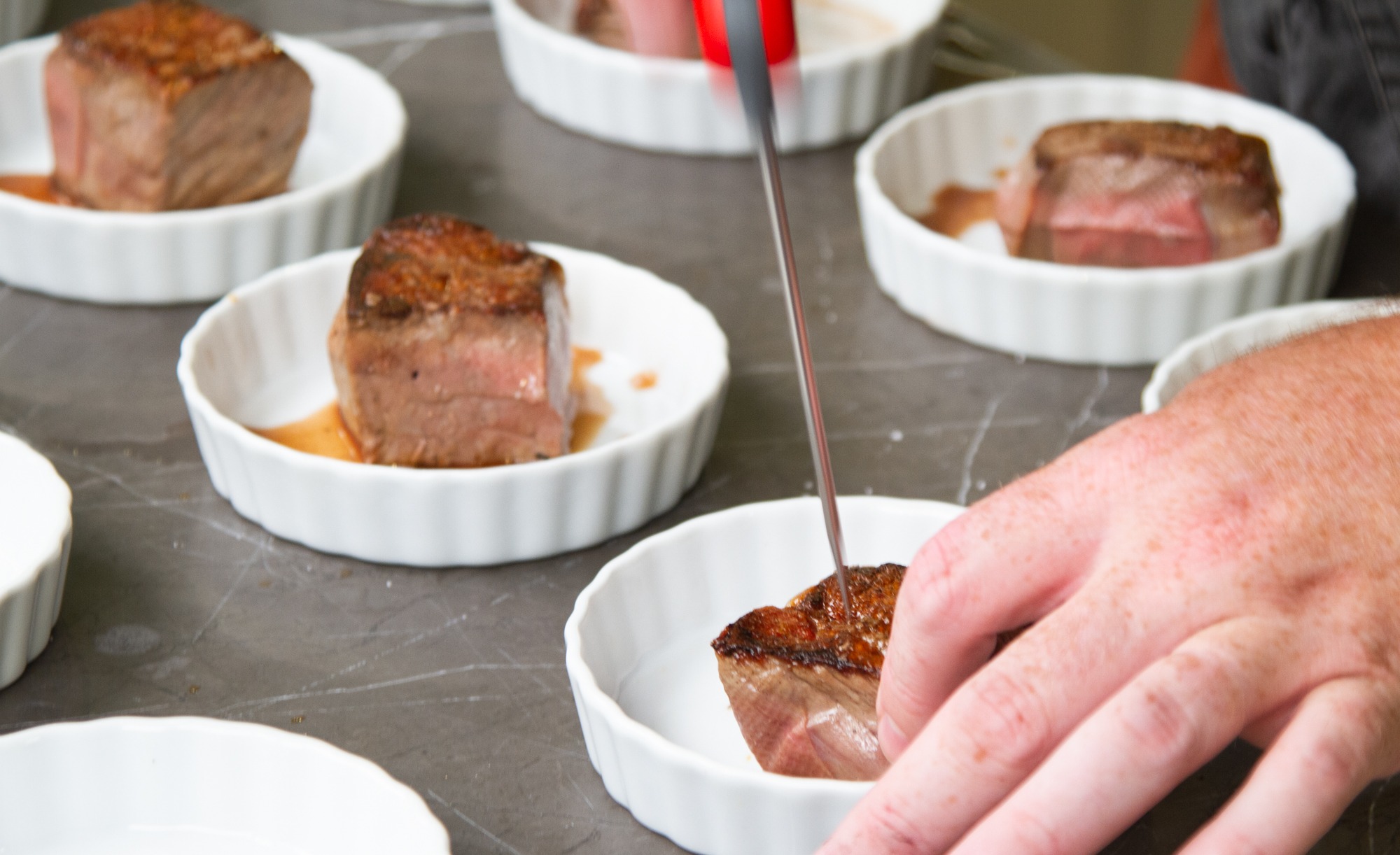
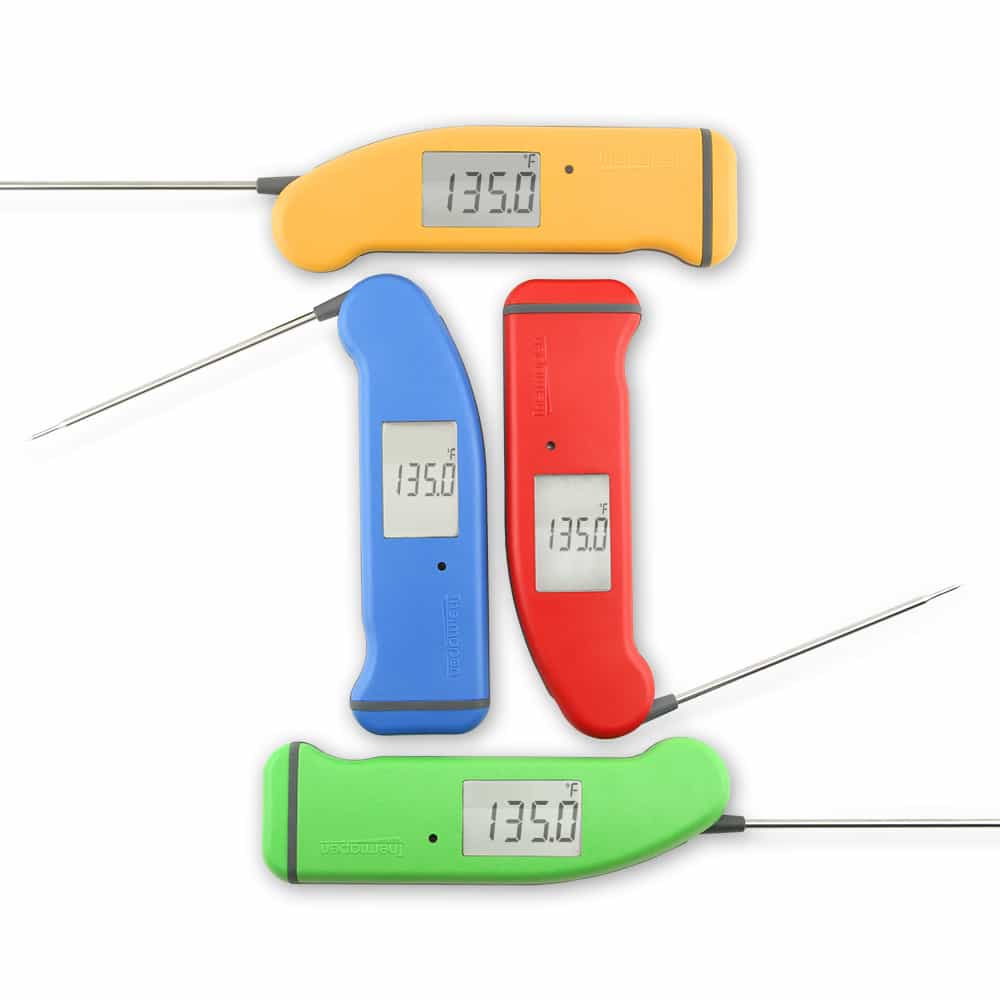
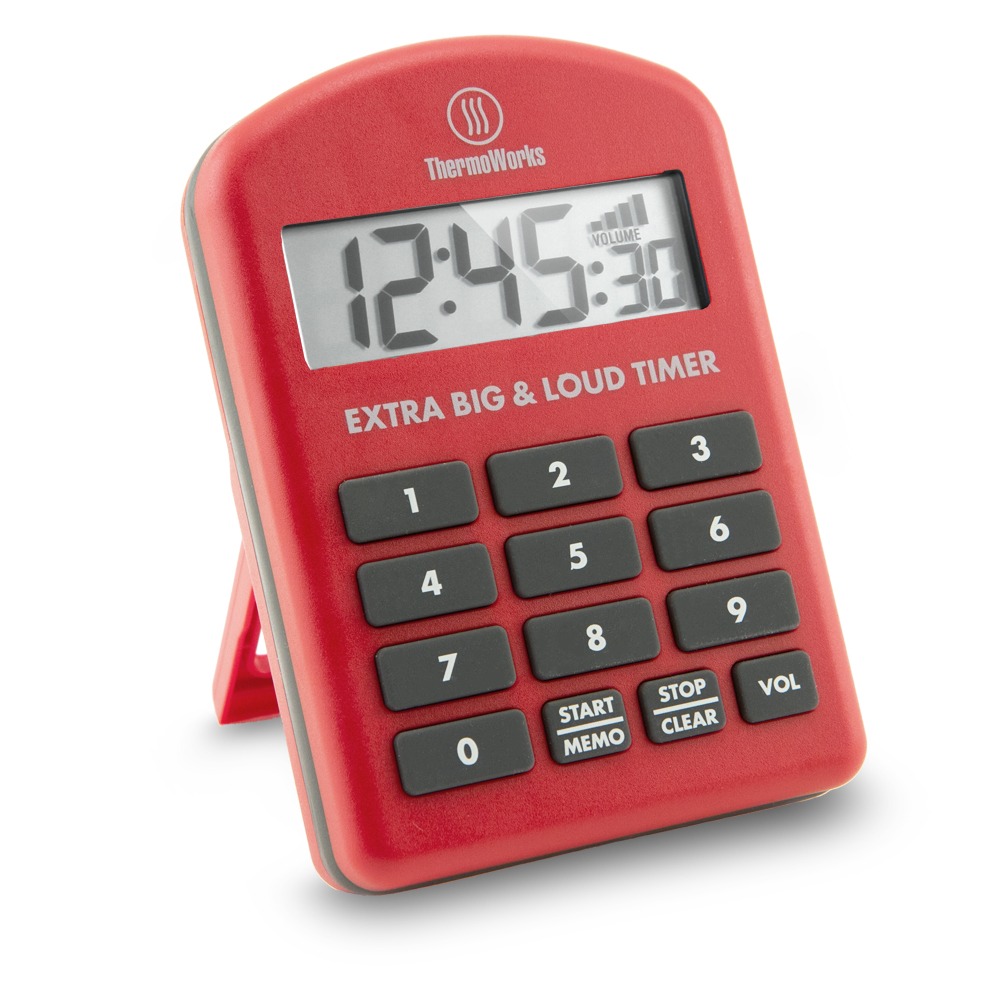
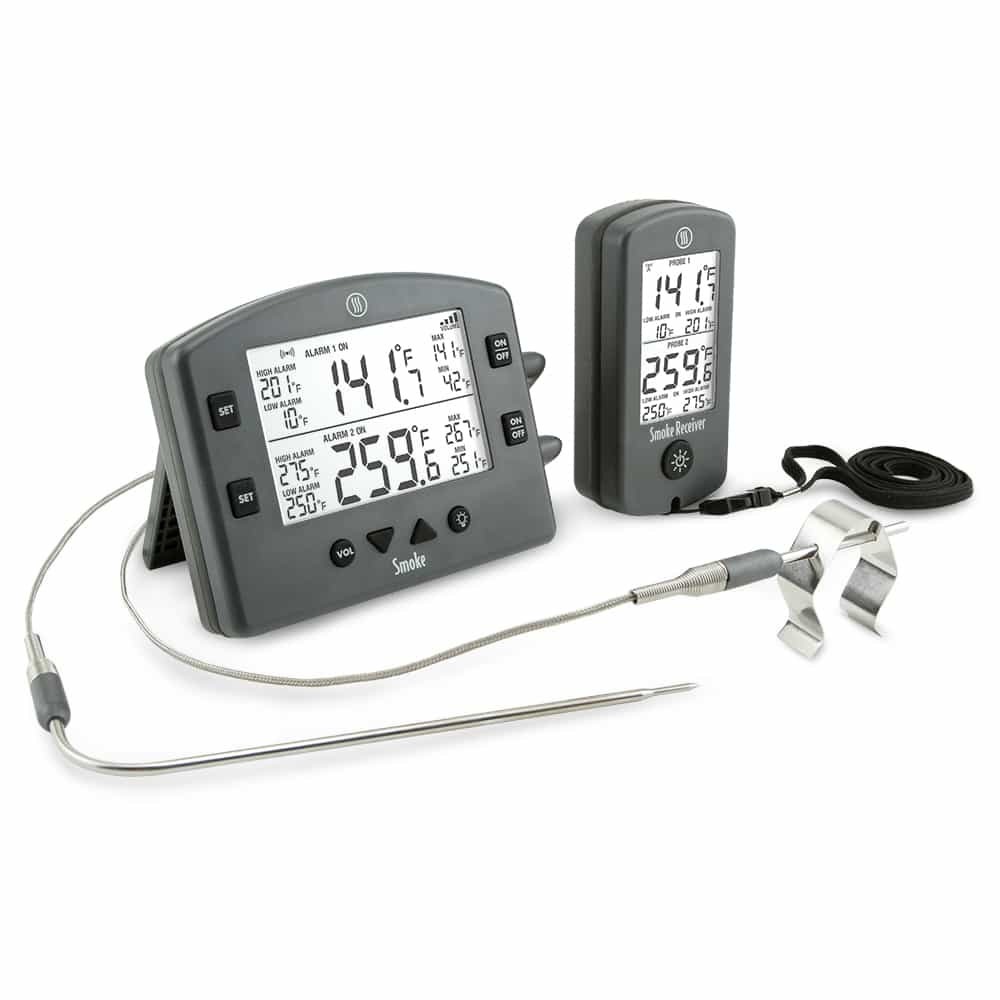
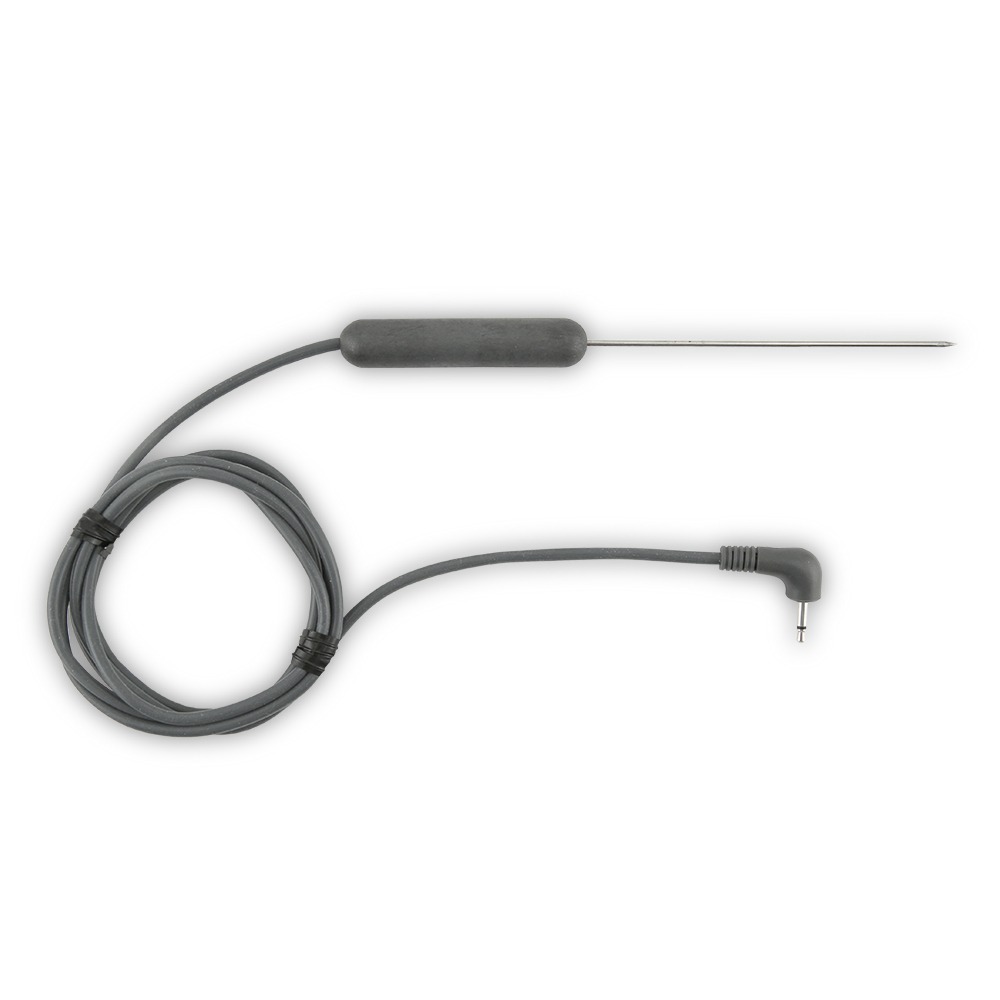
That’s interesting I’m not good at steaks I like mine cool in center so to get every ones Done right is hard but I’ll be getting your probe soon.
Thank you so much for doing this research. There’s fewer sins in this world worse than over cooking a good steak. Especially if you’re a pro and cooking for money. This is probably one of the best applications for the MK 4 and it’s nice to know that you’re pulling the steak at exactly the right temperature (and not guessing).
Also, I’m experimenting with the reverse sear method, either in the oven or sous-vide, and like the idea that you can sear the steak and eat/serve it without resting.
I’d like to see you do a similar test on the best way to cook brats.
This has been said before in a slightly different way. Check out Serious Eat’s Myths about Cooking Steaks. See Myth 6A. And, FYI, also look at Myth 7.
What a beautiful research project. You should present this at local or national meeting of Institute of Food Technologists.
I applaud your methods and scientific rigor to demonstrate the fallacy of an old wives tale which ranks right up there with you can’t wash a cast iron skillet with soap and water and microwaves cook from the inside out. It should be intuitively obvious to the most casual observer that steaks don’t lose all there juices when probed by anyone who has ever eaten a steak. A steak knife exposes more open surface area than a probe hole and steaks don’t “drain out” on your plate with the first or subsequent cuts. Keep up the great work
Since resting meat before it is cut is supposed to reduce the amount of juice lost, It seems that group 2 should have been probed as soon as it reached the correct temperature. The reason that the amount lost is less than group 1 is because you let it rest before probing it.
Dorothy,
We probed it as soon as it came out of the bath, before resting. It is true that the second and third pokes were made after resting, so that data may not be the most accurate, but the initial probing was done immediately as the steaks were removed from the baths.
Since the masses of the steaks were all different, comparing the mass of liquid lost doesn’t make sense. If we look at the loss as a percentage of initial mass, then the control lost a total of 20.05%, the probed steaks 18.39%, those cooked to 135 deg 20.04% and the 140 deg steaks 20.53%.
If we can say that “the juice that is lost by probing is statistically insignificant”, then the data shows that the juices lost by overcooking 10 degrees is even less significant.
It’s also interesting to note that the “doneness guides” lost less than half of the liquid of the other steaks. The other steaks lost about 7.5% during the sear and another 13.5% during the sous vide cook. These weren’t seared, but lost only about 8.5% total.
JWACKS,
Valid points, and I struggled with these questions when coming up with the experimental procedure. Ideally, a very wide range of steak masses would be cooked.
Most moisture loss in these cases seemed to come from the sear, but all steaks should be seared, so that is a loss that I think we must take. I surmise, though, that moisture loss for probing will not be proportional to steak size, as the moisture loss should be local to the probing site. Loss due to cooking, however, should be proportional, as the protein pressures will be exerted over the whole steak.
It could be argued that what we have here is borders on anecdotal. If I ever have the chance to cut up 2-3 whole striploins, I’ll get better data.